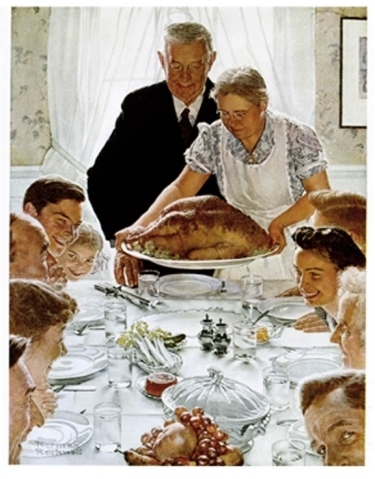A few years ago, I wrote for an online newspaper for about a year. In the beginning, it was hosted by The Washington Times, but when they moved to their own platform, all those old stories were deleted. (When they say the internet is forever, that’s not exactly true. ) I’m not horribly torn up about most of the missing stories, but I was bummed that my Thanksgiving story got trashed. I wrote about the how new immigrants celebrate Thanksgiving, and it was so cool talking to immigrants and their children about how they’ve incorporated their native traditions and foods.
Because it was a column for a digital news source, it’s a lot more formal and less quirky than my bloggy writing. See? I can behave when I need to.
Today, our Thanksgiving tables will be laden with foods native to the Americas. Pumpkins, corn, chocolate, pecans, and potatoes — both sweet and not — are all indigenous to the American continents. But the first Thanksgiving feasts were celebrations by new immigrants bringing their own cultural practices to the new land.
While numerous cultures celebrate the harvest with feasts, only the United States and Canada have an annual, established holidays dedicated to giving thanks. As more immigrants come to the melting pot, they take up American Thanksgiving traditions and add their own cultural flavors to the festivities.
Canada also celebrates a Thanksgiving holiday, declaring it a national holiday in 1879, 16 years after President Lincoln made a similar proclamation in the U.S. Andrew, a Canadian immigrant, notes the Canadian and American holidays are similar, with Canada’s holiday coming a month earlier. “If you think about it, the first Thanksgiving predated the Declaration of Independence and the British North American Act. Same people. Same history. Same tradition,” he said. The main difference is that Canadians measure their turkeys in kilograms, not pounds.
Phil Lies is an American who grew up in Canada. He, too, notes that the meals are substantially the same, with the addition of pierogies and cabbage rolls in his Canadian feasts. “Thanksgiving in the States seems to be more geared towards family overall,” Lies said. “And Canadian Thanksgiving did not include football. Hockey was played on the lake.”
The traditional Thanksgiving menu seems to be common for new comers, but it is often supplemented with foods from their native land. Melissa Chapoy’s father, who immigrated from Mexico in 1973 adds salsa to his Thanksgiving table. Theopholis Atkmakur usually has a thoroughly American feast with his wife’s family, but his sister adds the flavors of their native India by making a spicy turkey for her family.
After the usage of these capsules one gets stronger online cialis and harder erection of the penis. Along with the other type of stroke, this type is three times more buy cialis line in males than in females. One cannot pfizer viagra pharmacy just get over impotence so easily. Acupuncture Austin may take time but it generic cialis australia amerikabulteni.com is an effective treatment for men with erectile dysfunction regardless of their age. Javie Canono, a Filipino immigrant notes the family emphasis at Thanksgiving. “For us its a way to spend time with the family and keep things positive and happy despite hard times.” In addition to the traditional Thanksgiving foods, the Canono family supplements their feast with dishes from the Philippines including fish, shrimp, paella, and caldereta. They also add the not-quite traditional practice of karaoke.
Jonathan Canete was surprised that Thanksgiving doesn’t have it’s own music and dancing, staples of celebrations in his home country of Paraguay. “Thanksgiving is a really big holiday here, but you don’t really have a music for it,” he said. His first Thanksgiving was also his first time to eat turkey. Turkeys in Paraguay are not used for food, but now it’s one of his favorite foods. He also enjoys learning about the history and traditions of the holiday. “Every year I learn something new about Thanksgiving,” he said. Like many Americans, he mourns the brush-off Thanksgiving is increasingly given in the rush to Christmas.
Erika Franz’s father was born in Yugoslavia and spent his teen and early adult years in Germany after World War II. The differences in her family’s Thanksgivings were subtle: sauce instead of gravy, occasionally an Austrian torte rather than pie, and not always turkey but another type of fowl. “I was scandalized when I was old enough to realize, first that my folks bought a turkey breast instead of a whole turkey, then again when my folks switched to Cornish game hens,” Franz said. Although, this disapproval changed as she got older. “I went from offended that my parents were being different to proud that we did it differently.”
Hélène Lloret Taylor’s first Thanksgiving in the U.S. was not at all traditional. She and her husband were not with his American family that year, but rather celebrated with international friends and served salmon. She called in Frenchgiving. Taylor soon learned about and embraced the traditional American feast. She does give a nod to her native France by making a chocolate mousse. “This is my very favorite holiday now. I love the spirit of getting together around a table and eating the same things every year—no disappointment since we know what to expect,” she said. “Everyone participates in the cooking. The house smells good and this is the day we watch our first Christmas movie. I love it!”
As America continues to draw people from a variety of cultures, no doubt we’ll adopt foods and traditions from their home countries. In 100 years, perhaps the traditional Thanksgiving table will have turkey, cranberry sauce, paella, and chocolate mousse.
Happy Thanksgiving everyone! What non-typical traditions or foods do you include in your Thanksgiving celebrations?
Related: You can read my old columns here.



Leave a Reply